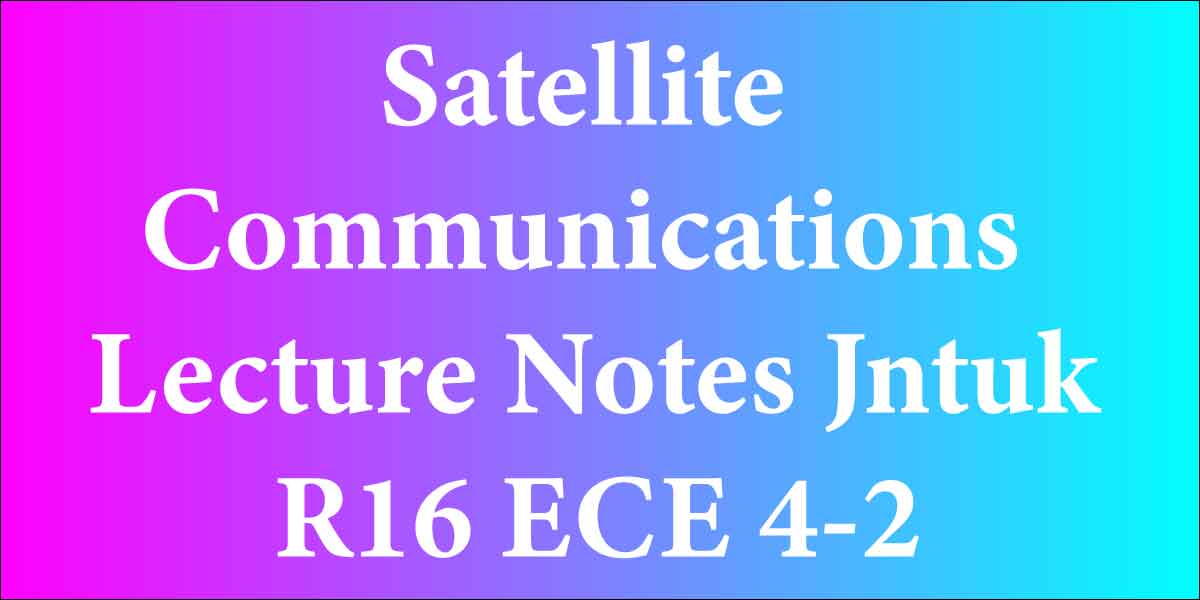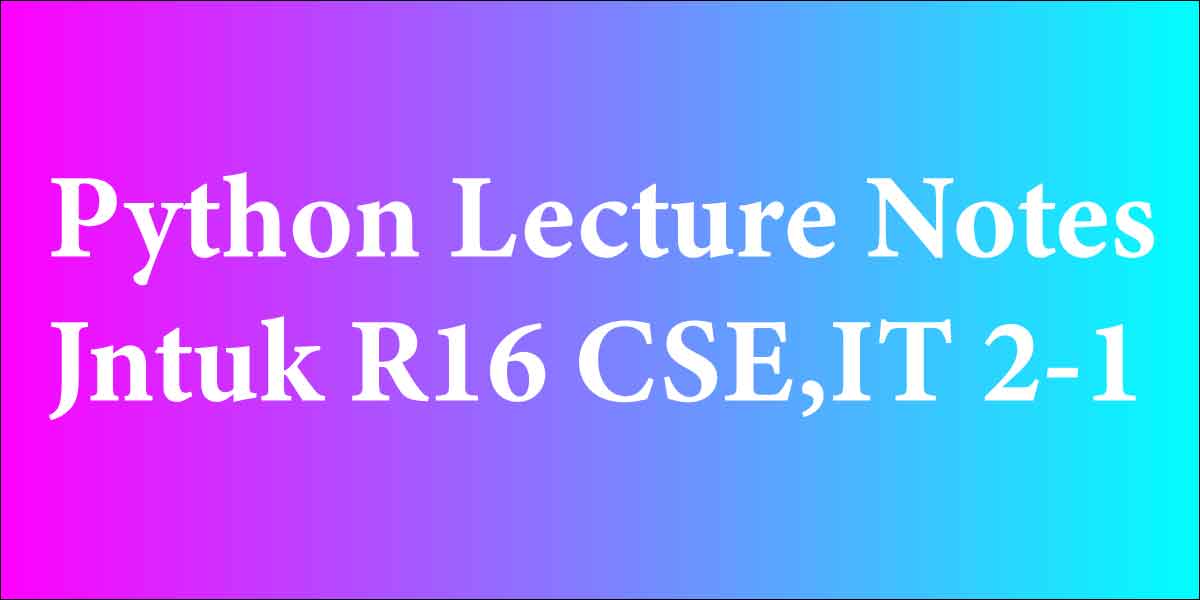
Satellite Communications Lecture Notes Jntuk R16 ECE 4-2
Satellite Communications
JntukMaterials R16 ECE 4-1 Satellite Communications notes Download for Only 10 rs in our website jntukmaterials.com

JntukMaterials R16 ECE 4-1 Satellite Communications notes Download for Only 10 rs in our website jntukmaterials.com

• to grant students AN introduction to elementary applied math, in preparation for courses on applied math analysis, random variables and random processes.
• To mathematically model the random phenomena with the assistance of applied math ideas.
• To introduce the necessary ideas of random variables and random processes.
• to research the LTI systems with stationary random method as input.
• To introduce the categories of noise and modelling noise sources.
THE variate : Introduction, Review of applied math, Definition of a variate, Conditions for a operate to be a variate, Discrete, Continuous and Mixed Random Variables, Distribution and Density functions, Properties, Binomial, Poisson, Uniform, Gaussian, Exponential, Rayleigh, Conditional Distribution, Conditional Density, Properties.
OPERATION ON ONE variate – EXPECTATIONS : Introduction, first moment of a variate, operate of a variate, Moments concerning the Origin, Central Moments, Variance and Skew, Chebychev’s difference, Characteristic operate, Moment Generating operate, Transformations of a variate: Monotonic Transformations for endless Random Variable, nonmonotonic Transformations of Continuous variate.
MULTIPLE RANDOM VARIABLES : Vector Random Variables, Joint Distribution operate, Properties of Joint Distribution, Marginal Distribution Functions, Conditional Distribution and Density, applied math Independence, add of 2 Random Variables, add of many Random Variables, Central Limit Theorem: Unequal Distribution, Equal Distributions. OPERATIONS ON MULTIPLE RANDOM VARIABLES: Joint Moments concerning the Origin, Joint Central Moments, Joint Characteristic Functions, collectivelymathematician Random Variables: 2 Random Variables case, N Random Variables case, Properties, Transformations of Multiple Random Variables, Linear Transformations of mathematician Random Variables.
RANDOM PROCESSES – TEMPORAL CHARACTERISTICS: The Random method idea, Classification of Processes, settled and Nondeterministic Processes, Distribution and Density Functions, idea of Stationarity and applied math Independence. First-Order Stationary Processes, Second-order and Wide-Sense Stationarity, Nth-order and Strict-Sense Stationarity, Time Averages and haphazardness, Autocorrelation operate and its Properties, Cross-Correlation operate and its Properties, variance Functions, mathematician Random Processes, Poisson Random method.
RANDOM PROCESSES – SPECTRAL CHARACTERISTICS: the facility Density Spectrum: Properties, Relationship between Power Density Spectrum and Autocorrelation operate, The Cross-Power Density Spectrum, Properties, Relationship between Cross-Power Density Spectrum and Cross-Correlation operate.
II Year – I Semester
L T P C
4 0 0 3
RANDOM VARIABLES PROCESSES
LINEAR SYSTEMS WITH RANDOM INPUTS : Random Signal Response of Linear Systems: System Response – Convolution, Mean and Mean-squared worth of System Response, Autocorrelation operate of Response, Cross-Correlation Functions of Input and Output, Spectral Characteristics of System Response: Power Density Spectrum of Response, Cross-Power Density Spectra of Input and Output, Band pass, Band-Limited and Narrowband Processes, Properties, Modeling of Noise supplys: Resistive (Thermal) Noise Source, impulsive Noise Sources, Effective Noise Temperature, Average Noise Figure, Average Noise Figure of cascaded networks.
one. likelihood, Random Variables & Random Signal Principles, Peyton Z. Peebles, TMH, fourthEdition, 2001. 2. likelihood, Random Variables and random Processes, Athanasios Papoulis and S.Unnikrisha, PHI, fourth Edition, 2002.
one. applied math and random Processes – B. Prabhakara Rao, baccalaureate Publications
two. likelihood and Random Processes with Applications to Signal process, Henry Stark and John W. Woods, Pearson Education, third Edition.
3. Schaum’s define of likelihood, Random Variables, and Random Processes.
4. AN Introduction to Random Signals and discipline, B.P. Lathi, International Textbook, 1968.
5. Random method – Ludeman , John Wiley half-dozen. applied math and Random Processes, P. Ramesh adult male, McGrawHill, 2015.
After completion of the course, the scholarareready to
• Mathematically model the random phenomena and solve easy probabilistic issues.
• establishdiffering types of random variables and reckonapplied math averages of those random variables.
• Characterize the random processes within the time and frequency domains.
• Analyze the LTI systems with random inputs.
• Apply these techniques to research the systems within the presence of various kinds of noise.

After taking the course, students will be able to
Use R for statistical programming, computation, graphics, and modeling, Write functions and use R in an efficient way,
Fit some basic types of statistical models
Use R in their own research,
Be able to expand their knowledge of R on their own.
Introduction, How to run R, R Sessions and Functions, Basic Math, Variables, Data Types, Vectors, Conclusion, Advanced Data Structures, Data Frames, Lists, Matrices, Arrays, Classes.
R Programming Structures, Control Statements, Loops, – Looping Over Nonvector Sets,- If-Else, Arithmetic and Boolean Operators and values, Default Values for Argument, Return Values, Deciding Whether to explicitly call return- Returning Complex Objects, Functions are Objective, No Pointers in R, Recursion, A Quicksort Implementation-Extended Extended Example: A Binary Search Tree.
Doing Math and Simulation in R, Math Function, Extended Example Calculating ProbabilityCumulative Sums and Products-Minima and Maxima- Calculus, Functions Fir Statistical Distribution, Sorting, Linear Algebra Operation on Vectors and Matrices, Extended Example: Vector cross Product- Extended Example: Finding Stationary Distribution of Markov Chains, Set Operation, Input /out put, Accessing the Keyboard and Monitor, Reading and writer Files,
Graphics, Creating Graphs, The Workhorse of R Base Graphics, the plot() Function – Customizing Graphs, Saving Graphs to Files. UNIT-V: Probability Distributions, Normal Distribution- Binomial Distribution- Poisson Distributions Other Distribution, Basic Statistics, Correlation and Covariance, T-Tests,-ANOVA.
Linear Models, Simple Linear Regression, -Multiple Regression Generalized Linear Models, Logistic Regression, – Poisson Regression- other Generalized Linear Models-Survival Analysis, Nonlinear Models, Splines- Decision- Random Forests,
At the end of this course, students will be able to:
List motivation for learning a programming language
Access online resources for R and import new function packages into the R workspace
Import, review, manipulate and summarize data-sets in R
Explore data-sets to create testable hypotheses and identify appropriate statistical tests
Perform appropriate statistical tests using R Create and edit visualizations with
1) The Art of R Programming, A K Verma, Cengage Learning.
2) R for Everyone, Lander, Pearson
3) The Art of R Programming, Norman Matloff, No starch Press. REFERENCE
1) R Cookbook, Paul Teetor, Oreilly.
2) R in Action, Rob Kabacoff, Manning
[content-egg module=Amazon template=list]

• Introduction to Scripting Language
• Exposure to varied issues determination approaches of engineering
Introduction:History of Python, would like of Python Programming, Applications Basics of Python
Programming victimisation the REPL(Shell), Running Python Scripts, Variables, Assignment,
Keywords, Input-Output, Indentation.
Types, Operators and Expressions: sorts – Integers, Strings, Booleans; Operators- Arithmetic
Operators, Comparison (Relational) Operators, Assignment Operators, Logical Operators,
Bitwise Operators, Membership Operators, Identity Operators, Expressions and order of
evaluations management Flow- if, if-elif-else, for, while, break, continue, pass
Data Structures Lists – Operations, Slicing, Methods; Tuples, Sets, Dictionaries, Sequences.
Comprehensions.
Functions – shaping Functions, vocation Functions, Passing Arguments, Keyword Arguments,
Default Arguments, Variable-length arguments, Anonymous Functions, Fruitful
Functions(Function Returning Values), Scope of the Variables in an exceedingly perform – international and native
Variables.
Modules: making modules, import statement, from. Import statement, name spacing,
Python packages, Introduction to PIP, putting in Packages via PIP, victimisation Python Packages
Object headed Programming OOP in Python: categories, ‘self variable’, Methods, creator
Method, Inheritance, dominant strategies, Datahiding,
Error and Exceptions: distinction between miscalculation and Exception, Handling Exception, try
except block, Raising Exceptions, User outlined Exceptions
II Year – I Semester
L T P C
4 0 0 3
Brief Tour of the quality Library – software Interface – String Pattern Matching,
Mathematics, net Access, Dates and Times, knowledge Compression, Multithreading, GUI
Programming, Turtle Graphics
Testing: Why testing is needed ?, Basic ideas of testing, Unit testing in Python, Writing
Test cases, Running Tests.
• creating code simply right out of the box.
• expertise with associate understood Language.
• to create code for real desires.
• previous Introduction to testing code

JntukMaterials here you can download jntuk R16 lecture notes from 1-1 to 4-2. Here you can download the Pulse and Digital Circuitsfor Ece 2-2